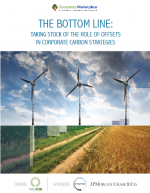The Bottom Line, Taking Stock Of The Role Of Offsets In Corporate Carbon Strategies
View PublicationAs the carbon content in the atmosphere rises to unprecedented levels, businesses are facing new risks. Delta Air Lines is concerned that rising temperatures could affect plane take-offs and that sea-level rise may encroach on coastal airports. Barclays bank is anticipating that tropical cyclones will alter the credit profile of some of their clients. Cosmetics company Natura Cosméticos worries that temperature changes may distress the plants they use in their make-up, perhaps leading to biodiversity loss. And retailer Marks & Spencer is preparing its retail outlets for higher air conditioning and heating costs due to temperature extremes.
Aside from facing climate change risks, the companies mentioned above have something else in common: They all voluntarily purchase carbon offsets as part of a carbon management strategy.
Forest Trends Ecosystem Marketplace estimates that voluntary demand for carbon offsets – delineated in tonnes of carbon dioxide equivalent, or tCO2e – reached a cumulative 844 million tCO2e over the last decade. Data from CDP (formerly the Carbon Disclosure Project) reveals that 14% of all companies reporting emissions data to CDP practice offset-inclusive carbon management. That’s a total of 265 companies with an emissions footprint of almost 6 billion tCO2e, which no doubt comprise a significant proportion of the last decade’s offset demand.
These same companies are prioritizing energy efficiency, purchasing or installing renewable energy, shifting agricultural production from primary forest to degraded lands, and engaging staff and customers around ecological goals – all in the name of mitigating their contribution and adapting to a riskier physical and business climate.
Carbon offsetting can support these goals in several ways. For some companies, such as carpetmaker Interface, offsets are a way to neutralize the carbon footprint of a product after exhausting all other means of cutting emissions. Other corporations use offsetting to mitigate emissions in their supply chain, sometimes as an interim measure as they work with suppliers to reduce emissions directly.

